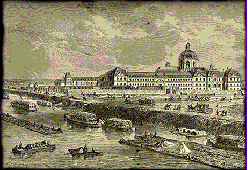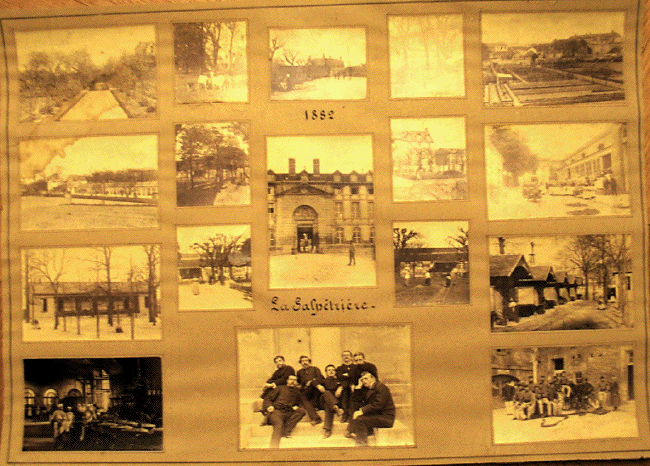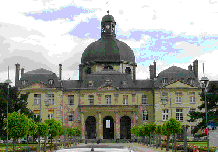- The history of the Pitié and
Salpêtrière hospitals began 4
centuries ago, and encompasses the
development of psychiatry, neurology,
neuropathology, neurosurgery, neuroradiology,
and more generally, neuroscience, in France.
La Pitié and La
Salpêtrière were both created at
the beginning of the 17th century. La
Pitié was first installed facing the
Jardin des Plantes (where the Paris mosque is
now located), and used to be a beggars'
asylum. The history of La
Salpêtrière began in 1634, when
the arsenal was transferred from the Bastille
area to the confluent of the Bièvre.
The arsenal was called La
Salpêtrière, because of the
saltpeter that was used to make gunpowder.
The royal edict of 1656 ordered the
«grand renfermement», i.e. the
confinement of the poor inside the
«Hôpital Général de
la Ville de Paris», that comprised 8
institutions, of which La Pitié and La
Salpêtrière were among the most
important. These hospitals had no obligation
to care for the ill, they were only a shelter
for the poor, the disabled, the insane,
orphans, abandoned children, the destitute
elderly and women of «easy virtue».
In 1684, in addition to the beggars' asylum,
a prison, «La Force», was
established in the Salpêtrière,
for about 300 common law female prisoners and
prostitutes. This prison was used until the
French Revolution.
-
 - Trois
souvenirs, La Salpêtrière.
A. Daudet. 1896
-
- The birth of psychiatry at
Salpêtrière : Pinel and the
hospital alienists
- In 1801, the Hôpital
Général became the
«Hospices Civils». From 1837 to
1887, La Salpêtrière housed aged
women («Hospice de la
Vieillesse-Femmes»), and Bicêtre
aged men. Prostitutes, convicts, young girls,
sick people went elsewhere; only elderly and
insane women remained.
-
- It was there that the alienists of Paris
hospitals, founded modern medicine for the
mentally ill. Between 1785 and 1826, Pinel
(and his ward-supervisor Pussin), Esquirol
and their successors, greatly contributed to
the development of modern psychiatry.
-
- Later on, mental diseases were treated in
psychiatric hospitals, but Heuyer, Michaux,
Duché, and their successors at La
Salpêtrière continued to devote
themselves to child and adolescent psychiatry
and Widlöcher and his school to the
treatment of adults.
-
- The birth of neurology and
neuropathology : Charcot,
Vulpian and the School of
Salpêtrière
- In 1862, Jean-Martin Charcot (1845-1893)
and his friend Vulpian, became directors of
clinics at the Salpêtrière.
Vulpian left 5 years later, but Charcot
stayed for more than 30 years - a very
unusual event- until his death in 1893. At
the Salpêtrière, at this period,
there were only 2 clinics of medicine, 5 for
mental diseases, headed by alienists, and 1
for general surgery. The Hospice
Vieillesse-Femmes, as it was still called,
counted 4,422 beds, two third of which were
reserved for mentally unimpaired indigents
and epileptics, and one third for mentally
deranged women.
- Charcot and Vulpian began a systematic
anatomo-clinical study of this truly
«living museum of pathology» with
hundreds of chronic patients in their two
medical departments. Their enormous
accomplishements cannot be summarized in a
few lines. No type of nervous system disorder
was excluded: multiple sclerosis, amyotrophic
lateral sclerosis, also called Charcot's
disease, Charcot-Marie-Tooth disease,
cerebral localization, and, of course, the
study of hysteria which contributed to
Charcot's world-wide reputation.
-
- In 1882, a specific chair for neurology
was created, the «Clinique des Maladies
du Système Nerveux» which was the
summit of Charcot's career. His successors
maintained the anatomo-clinical tradition
that he had initiated with Vulpian: Brissaud
(ad interim), Raymond,
Déjérine, Pierre Marie,
Guillain, Alajouanine and Castaigne, the last
occupant of Charcot chair, all contributed to
the development of this field.
Neuropsychology, especially the study of
speech and language, was illustrated in
particular by the work of Alajouanine and his
school, François Lhermitte, Jean-Louis
Signoret and their successors. This was,
however, not the only neurology department in
the Salpêtrière; there were
others as well, directed by Souques,
Hagueneau, Garcin, Boudin, Buge and their
successors, which gave rise to major
scientific discoveries.
-
- Neuropathology, initially practiced by
the neurologists, gained its independance. It
was first concerned with the anatomopathology
of the nervous system, still a satellite of
clinical neurology, with Ivan Bertrand at the
Clinique des Maladies du Système
Nerveux at the Salpêtrière,
Jean-Emmanuel Grüner then
Jean-François Foncin in the
Salpêtrière neurosurgery clinic,
Henri Berdet then Roger Messimy in
neurosurgery at La Pitié. More
recently, neuropathology and
histology-embryology departments were
created, the former by Raymond Escourolle,
the latter by Jean Racadot.
-
- The Neurology School of la
Pitié and the foundation of
neurosurgery : Babinski, Thierry de Martel
and Clovis Vincent
- At the beginning of the 19th century,
under the impetus of Serres, la Pitié
became a center for the study of nervous
diseases. Its most famous medical doctor was,
without any doubt, Joseph Babinski
(1857-1932) whose extensor plantar reflex,
the Babinski sign, is known world-wide .
First trained by Charcot, he became head of a
department at La Pitié January 1,
1895.
- In 1913, after the demolition of the
ancient Pitié, he installed his
department in the new buildings of the newly
constructed Pitié, inside the gardens
of the Salpêtrière, which was
built where it now stands. The
accomplishments of Babinski were essentially
clinical, aimed at finding objective signs of
the organic nature of neurological symptoms,
that distinguish them from hysteria. He thus
elaborated the semiology of the cerebellar
syndrome and described his now classical sign
for pyramidal syndromes. His name is also
attached to several neurological syndromes:
Babinski-Froehlich, Babinski-Nageotte,
Anton-Babinski.
-
- During the first years of the 20th
century, Babinski initiated neurosurgery in
France. Thierry de Martel, then Clovis
Vincent, performed the operations. Antoine
Chipault (1866-1920), head of a surgery
clinic at the Salpêtrière, had
previously practiced neurosurgery, but his
work remained unknown.
-
- In 1933, a neurosurgery department was
created for Clovis Vincent (1879-1947), at La
Pitié. In 1938, the first chair of
neurosurgery was also created for him there.
He was succeeded by Petit-Dutaillis, Marcel
David and Bertrand Pertuiset.
- Neurology was practiced not only at La
Salpêtrière, neurosurgery not
only at La Pitié. Guillaume, who
succeeded Clovis Vincent, assistant to
Thierry de Martel, started as a neurosurgeon
at La Salpêtrière, in the
surgery departments of Antonin Gosset, then
Henri Mondor, before becoming the head of the
first neurosurgery department of La
Salpêtrière. Lebeau succeeded
him in 1960.
-
- New fields of specialization developped :
neurophysiology and neuroradiology, more
recently neuroimaging. The pioneering work of
Hermann Fishgold, closely liked to the
neurosurgery department of the Pitié,
and of Jean Scherrer in neurophysiology,
should be underlined.
-
- Pitié-Salpêtrière
in the recent years : a multidisciplinary
university hospital with a strong focus on
neurosciences
- The present era began in the 1960's with
:
- • the fusion of La Pitié and
La Salpêtrière which gave rise
toPitié-Salpêtrière
hospital center;
- • the destruction of the
«Infirmerie Générale»
which dated from the end of the 18th century,
and which was replaced by a new Clinic for
the Diseases of the Nervous System, and the
Neuropathology Laboratory Charles Foix
(1965);
- • the disappearance of the remaining
elderly (1969);
- • the creation of the
Pitié-Salpêtrière Medical
School (1968) with the
Pitié-Salpêtrière as the
University Hospital, in association with the
Broca Hospital and the Hospice of Ivry.
-
- The Faculty of Medicine, which is part of
the University of Paris VI (Pierre and Marie
Curie), occupies two buildings, 91 and 105
Boulevard de l'Hôpital.
-
- Thanks to the dean Paul Castaigne, an
important university hospital developed where
most fields of medicine were represented,
but, in keeping with its past history,
neurology predominated. There are now many
neurology, neurosurgery, adult adolescent and
child psychiatry clinics. There are also
medico-technical departments :
neuroradiology, neurophysiology,
neuropathology and histo-embryology.
-
- Some of these were recently grouped
together in the modern Babinski building
where the Myology Institute is also located.
In addition, since the 1970s, a number of
neuroscience research groups in neurobiology,
neurochemistry, neuropharmacology,
neurogenetics, neuroimmunology,
neuroepidemiology, functional imaging and
neurophysiology of integrated systems have
progressively developed, under the auspices
of the National Research Institutes. All
aspects of neuroscience and cogniscience are
represented in the Federated Institute of
Neuroscience Research. This research
institute is jointl administered by
Assistance Publique-Hôpitaux de Paris
(AP-HP), Centre National de la Recherche
Scientifique (CNRS), Institut National de la
Santé et de la Recherche
Médical (INSERM),Université
Pierre et Marie Curie (UPMC).
-
- The neurological tropism of the
Pitié-Salpêtrière is also
reinforced by the presence of the Charcot
library located above the Charcot lecture
hall and next to the «Clinique des
Maladies du Système Nerveux Paul
Castaigne». It contains not only the
medico-scientific heritage of Charcot, but
also the Souques library and one of the
residents of the
Salpêtrière
- Hospital, started in the early ages of
neurology. It is now a university library,
with which the Charcot Institute is
associated. It is specialized in neurology,
and is growing in the neurosciences.
-
- The French Neurology Society, founded in
1949 as an offshoot of the Paris Neurology
Society, holds its monthly
- meeting in the Charcot Lecture Hall. The
main office of the Society for the History of
Neurology, founded in 1991, with Jean-Louis
Signoret as first president, is also in the
Charcot Library.
-
- Thus, for over four hundred years, from
the beginning of the 17th century, to the end
of the 20th century, two distinct hospitals,
that initially served social functions
beggars asylum, prison, hospice for elderly
and insane women, developed from the 19th
century on, under Pinel, Esquirol, Charcot,
Vulpian, Babinski, Clovis Vincent (to name
only the major figures), into an
establishment for medical care, teaching and
research, that is particularly well known for
the treatment of mental disorders, diseases
of the nervous system, and more recently,
research in neuroscience.
-
- The union, in the sixties, of La
Pitié and La Salpêtrière
Hospitals, with the
Pitié-Salpêtrière Medical
School, led, under the direction of the dean
Paul Castaigne, to the development of a
multidisciplinary University and Hospital
Center. Its historical neurological vocation
has been reinforced with the vitality of the
Federated Institute of Neuroscience
Research.
-

|




